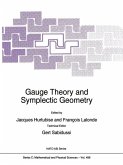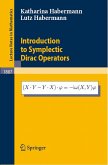The goal of these notes is to provide a fast introduction to symplectic geometry for graduate students with some knowledge of differential geometry, de Rham theory and classical Lie groups.
This text addresses symplectomorphisms, local forms, contact manifolds, compatible almost complex structures, Kaehler manifolds, hamiltonian mechanics, moment maps, symplectic reduction and symplectic toric manifolds. It contains guided problems, called homework, designed to complement the exposition or extend the reader's understanding.
There are by now excellent references on symplectic geometry, a subset of which is in the bibliography of this book. However, the most efficient introduction to a subject is often a short elementary treatment, and these notes attempt to serve that purpose. This text provides a taste of areas of current research and will prepare the reader to explore recent papers and extensive books on symplectic geometry where the pace is much faster.
For this reprint numerous corrections and clarifications have been made, and the layout has been improved.
This text addresses symplectomorphisms, local forms, contact manifolds, compatible almost complex structures, Kaehler manifolds, hamiltonian mechanics, moment maps, symplectic reduction and symplectic toric manifolds. It contains guided problems, called homework, designed to complement the exposition or extend the reader's understanding.
There are by now excellent references on symplectic geometry, a subset of which is in the bibliography of this book. However, the most efficient introduction to a subject is often a short elementary treatment, and these notes attempt to serve that purpose. This text provides a taste of areas of current research and will prepare the reader to explore recent papers and extensive books on symplectic geometry where the pace is much faster.
For this reprint numerous corrections and clarifications have been made, and the layout has been improved.
Dieser Download kann aus rechtlichen Gründen nur mit Rechnungsadresse in A, B, BG, CY, CZ, D, DK, EW, E, FIN, F, GR, HR, H, IRL, I, LT, L, LR, M, NL, PL, P, R, S, SLO, SK ausgeliefert werden.
From the reviews of the first printing
"Over the years, there have been several books written to serve as an introduction to symplectic geometry and topology, [...] The text under review here fits well within this tradition, providing a useful and effective synopsis of the basics of symplectic geometry and possibly serving as the springboard for a prospective researcher.
The material covered here amounts to the 'usual suspects' of symplectic geometry and topology. From an introductory chapter of symplectic forms and symplectic algebra, the book moves on to many of the subjects that serve as the basis for current research:symplectomorphisms, Lagrangian submanifolds, the Moser theorems, Darboux-Moser-Weinstein theory, almost complex structures, Kãhler structures, Hamiltonian mechanics, symplectic reduction, etc.
The text is written in a clear, easy-to-follow style, that is most appropriate in mathematical sophistication for second-year graduate students; [...].
This text had its origins in a 15-week course that the author taught at UC Berkeley. There are some nice passages where the author simply lists some known results and some well-known conjectures, much as one would expect to see in a good lecture on the same subject. Particularly eloquent is the author's discussion of the compact examples and counterexamples of symplectic, almost complex, complex and Kähler manifolds.
Throughout the text, she uses specific, well-chosen examples to illustrate the results. In the initial chapter, she provides a detailed section on the classical example of the syrnplectic structure of the cotangent bundle of a manifold.
Showing a good sense of pedagogy, the author often leaves these examples as well-planned homework assignments at the end of some of the sections. [...] In all of these cases, the author gives the reader a chance to illustrate and understand the interesting results of each section, rather than relegating the tedious but needed results to the reader."
Mathematical Reviews 2002i
"Over the years, there have been several books written to serve as an introduction to symplectic geometry and topology, [...] The text under review here fits well within this tradition, providing a useful and effective synopsis of the basics of symplectic geometry and possibly serving as the springboard for a prospective researcher.
The material covered here amounts to the 'usual suspects' of symplectic geometry and topology. From an introductory chapter of symplectic forms and symplectic algebra, the book moves on to many of the subjects that serve as the basis for current research:symplectomorphisms, Lagrangian submanifolds, the Moser theorems, Darboux-Moser-Weinstein theory, almost complex structures, Kãhler structures, Hamiltonian mechanics, symplectic reduction, etc.
The text is written in a clear, easy-to-follow style, that is most appropriate in mathematical sophistication for second-year graduate students; [...].
This text had its origins in a 15-week course that the author taught at UC Berkeley. There are some nice passages where the author simply lists some known results and some well-known conjectures, much as one would expect to see in a good lecture on the same subject. Particularly eloquent is the author's discussion of the compact examples and counterexamples of symplectic, almost complex, complex and Kähler manifolds.
Throughout the text, she uses specific, well-chosen examples to illustrate the results. In the initial chapter, she provides a detailed section on the classical example of the syrnplectic structure of the cotangent bundle of a manifold.
Showing a good sense of pedagogy, the author often leaves these examples as well-planned homework assignments at the end of some of the sections. [...] In all of these cases, the author gives the reader a chance to illustrate and understand the interesting results of each section, rather than relegating the tedious but needed results to the reader."
Mathematical Reviews 2002i
"I find this to be both the best introduction to symplectic geometry as well as a model for how to introduce any field of study. ... one feels the hand of a master in the text's homework sets: concrete, illustrative, and enhancing the material presented. ... For an upper-level undergraduate or beginning graduate student, Lectures on Symplectic Geometry remains, in my opinion, an ideal starting point into an exciting, active and growing area of mathematics." (Andrew McInerney, MAA Reviews, June, 2018)
From the reviews of the first printing
Over the years, there have been several books written to serve as an introduction to symplectic geometry and topology, [...] The text under review here fits well within this tradition, providing a useful and effective synopsis of the basics of symplectic geometry and possibly serving as the springboard for a prospective researcher.
The material covered here amounts to the "usual suspects" of symplectic geometryand topology. From an introductory chapter of symplectic forms and symplectic algebra, the book moves on to many of the subjects that serve as the basis for current research:symplectomorphisms, Lagrangian submanifolds, the Moser theorems, Darboux-Moser-Weinstein theory, almost complex structures, Kãhler structures, Hamiltonian mechanics, symplectic reduction, etc.
The text is written in a clear, easy-to-follow style, that is most appropriate in mathematical sophistication for second-year graduate students; [...].
This text had its origins in a 15-week course that the author taught at UC Berkeley. There are some nice passages where the author simply lists some known results and some well-known conjectures, much as one would expect to see in a good lecture on the same subject. Particularly eloquent is the author's discussion of the compact examples and counterexamples of symplectic, almost complex, complex and Kähler manifolds.
Throughout the text, she uses specific, well-chosen examples to illustrate the results. In the initial chapter, she provides a detailed section on the classical example of the syrnplectic structure of the cotangent bundle of a manifold.
Showing a good sense of pedagogy, the author often leaves these examples as well-planned homework assignments at the end of some of the sections. [...] In all of these cases, the author gives the reader a chance to illustrate and understand the interesting results of each section, rather than relegating the tedious but needed results to the reader.
Mathematical Reviews 2002i
From the reviews of the first printing
Over the years, there have been several books written to serve as an introduction to symplectic geometry and topology, [...] The text under review here fits well within this tradition, providing a useful and effective synopsis of the basics of symplectic geometry and possibly serving as the springboard for a prospective researcher.
The material covered here amounts to the "usual suspects" of symplectic geometryand topology. From an introductory chapter of symplectic forms and symplectic algebra, the book moves on to many of the subjects that serve as the basis for current research:symplectomorphisms, Lagrangian submanifolds, the Moser theorems, Darboux-Moser-Weinstein theory, almost complex structures, Kãhler structures, Hamiltonian mechanics, symplectic reduction, etc.
The text is written in a clear, easy-to-follow style, that is most appropriate in mathematical sophistication for second-year graduate students; [...].
This text had its origins in a 15-week course that the author taught at UC Berkeley. There are some nice passages where the author simply lists some known results and some well-known conjectures, much as one would expect to see in a good lecture on the same subject. Particularly eloquent is the author's discussion of the compact examples and counterexamples of symplectic, almost complex, complex and Kähler manifolds.
Throughout the text, she uses specific, well-chosen examples to illustrate the results. In the initial chapter, she provides a detailed section on the classical example of the syrnplectic structure of the cotangent bundle of a manifold.
Showing a good sense of pedagogy, the author often leaves these examples as well-planned homework assignments at the end of some of the sections. [...] In all of these cases, the author gives the reader a chance to illustrate and understand the interesting results of each section, rather than relegating the tedious but needed results to the reader.
Mathematical Reviews 2002i









